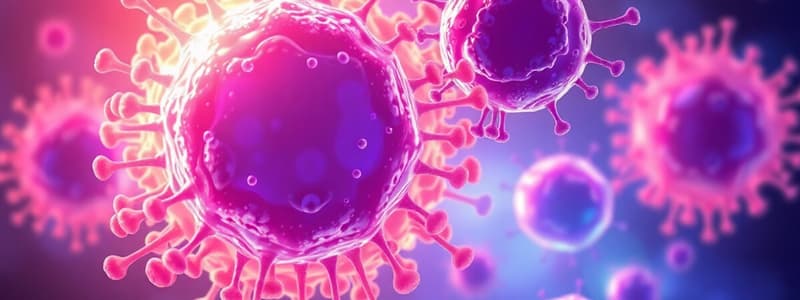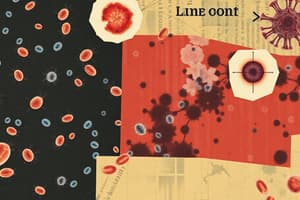Podcast
Questions and Answers
What chromosome contains the k light chain genes?
What chromosome contains the k light chain genes?
- Chromosome 2 (correct)
- Chromosome 6
- Chromosome 14
- Chromosome 22
How many potential Vk regions can be produced from k light chain genes?
How many potential Vk regions can be produced from k light chain genes?
- 550
- 190 (correct)
- 120
- 38
Which components are involved in forming the light chain V region?
Which components are involved in forming the light chain V region?
- V segment and J segment (correct)
- V segment and D segment
- J segment and C segment
- C segment and J segment
What is the total number of different antibody specificities that can potentially be produced by combining heavy and light chains?
What is the total number of different antibody specificities that can potentially be produced by combining heavy and light chains?
Which light chain gene type has a greater number of V gene segments?
Which light chain gene type has a greater number of V gene segments?
What is one of the primary functions of B cells in the adaptive immune response?
What is one of the primary functions of B cells in the adaptive immune response?
Which mechanism is NOT involved in generating antibody diversity among B cells?
Which mechanism is NOT involved in generating antibody diversity among B cells?
What occurs during the process of clonal selection in B cells?
What occurs during the process of clonal selection in B cells?
Which type of B cell is primarily found in the marginal zone of the spleen?
Which type of B cell is primarily found in the marginal zone of the spleen?
What is the approximate number of unique antibody specificities in humans?
What is the approximate number of unique antibody specificities in humans?
What distinguishes B cells from other lymphocytes during development?
What distinguishes B cells from other lymphocytes during development?
Where does the activation of adaptive immunity primarily occur?
Where does the activation of adaptive immunity primarily occur?
Which of these options accurately describes the interaction between B cells and antigens?
Which of these options accurately describes the interaction between B cells and antigens?
Flashcards
Light chain V region recombination
Light chain V region recombination
The variable (V) and joining (J) segments of the light chain gene recombine to form the complete V region.
V and C region separation
V and C region separation
The V region is located upstream of the constant (C) region, and they are separated by non-coding sequences that are removed during RNA splicing.
Somatic gene recombination
Somatic gene recombination
The process of rearranging DNA segments in immune cells to generate diverse antibodies.
Antibody diversity
Antibody diversity
Signup and view all the flashcards
k Light chain gene location
k Light chain gene location
Signup and view all the flashcards
Adaptive Immunity
Adaptive Immunity
Signup and view all the flashcards
B cells
B cells
Signup and view all the flashcards
What are B cells?
What are B cells?
Signup and view all the flashcards
What is the clonal selection theory?
What is the clonal selection theory?
Signup and view all the flashcards
How is antibody diversity generated?
How is antibody diversity generated?
Signup and view all the flashcards
What is somatic gene recombination?
What is somatic gene recombination?
Signup and view all the flashcards
What are the types of B cells?
What are the types of B cells?
Signup and view all the flashcards
What is the function of antibodies?
What is the function of antibodies?
Signup and view all the flashcards
What are plasma cells?
What are plasma cells?
Signup and view all the flashcards
What are memory B cells?
What are memory B cells?
Signup and view all the flashcards
Study Notes
B Cells
- B cells are key components of the adaptive immune response.
- They play critical roles in antibody production and antigen presentation.
- B cells are central to the clonal selection theory.
- Clonal selection theory proposes antigen-specific B cells are activated and expanded upon encountering their cognate antigen.
- This theory is fundamental to understanding how the immune system responds to diverse pathogens.
- Antibody diversity is generated through processes including somatic hypermutation.
- This ensures a broad repertoire of antibodies capable of recognizing various antigens.
Adaptive Immune Response
- The adaptive response begins approximately 96 hours after initial infection.
- It is activated if the innate immune system fails to control the infection.
- B and T lymphocytes are the key players in the adaptive response.
- B cells mediate the adaptive humoral immune response.
- B cells produce antibodies (plasma cells).
- T cells mediate the adaptive cell-mediated immune response.
- T cells include Tc, Th1, Th2, TEH, and Th17 cells.
- Activation of the adaptive immune response occurs in secondary lymphoid tissue (e.g., lymph nodes, spleen, MALT).
Clonal Selection Theory
- Each lymphocyte has a unique receptor with specific characteristics.
- Foreign antigen interaction with the lymphocyte receptor leads to lymphocyte activation.
- Activated lymphocytes proliferate (increase in number) and differentiate into effector cells.
- These effector cells have identical antigen receptors to the original parent cell.
- Lymphocytes with self-molecule receptors are deleted early in development, ensuring they are absent from mature lymphocytes.
B Cell Types
- There are three major types of B cells.
- B1 cells are located in the peritoneal and pleural cavities.
- Marginal zone B cells are found in the marginal zone of the spleen.
- Follicular B cells reside in B cell follicles within lymphatic tissue.
Antibody Diversity
- Each B cell produces an antibody with unique specificity.
- The collection of antibody specificities is called the antibody repertoire.
- Humans possess approximately 10^11 antibody specificities.
- Encoding each specificity via separate genes is inefficient.
- Antibody diversity arises from somatic gene recombination and somatic hypermutation.
Somatic Gene Recombination
- DNA encoding antibody variable and constant regions is separated in all cells except B cells.
- During B cell development, coding segments are brought together to create functional antibody molecules.
- This occurs for both heavy and light chains.
- Light chain genes, like kappa (κ) and lambda (λ), exist.
- Kappa light chain genes are located on chromosome 2.
- Lambda light chain genes are on chromosome 22.
- The light chain V region is derived from combining V (variable) and J (joining) gene segments.
- The V gene segment encodes the first amino acids (95-101).
- The J gene segment codes for the rest of the domain (~13 residues).
- V region DNA is separated from the C region DNA by non-coding sequences removed through RNA splicing.
- For kappa light chains, approximately 38 V segments and 5 J segments exist.
- For lambda light chains, roughly 30 V segments and 4 J segments are observed.
- A variety of V regions potentially are produced (e.g., 190 for kappa and 120 for lambda).
- Heavy chain genes comprise V, D (diversity), and J gene segments.
- This results in about 5,520 likely V regions and ~1.7 x 10^6 different antibody specificities from combining H and L chains.
Additional Diversity Mechanisms
- Imprecise joining of segments: Nucleotide additions or deletions during segment joining lead to variability.
- Non-functional rearrangements are eliminated.
- Somatic hypermutation: Point mutations in V regions of rearranged H and L chain genes occur in secondary lymphoid organs.
- High-affinity antibodies are generated during an immune response.
Studying That Suits You
Use AI to generate personalized quizzes and flashcards to suit your learning preferences.



